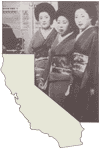![]()

Five Views: An Ethnic Historic Site Survey for California
MENU
Introduction
Immigration
Settlement
Organizations/Religion
Discrimination
World War II Incarceration
Historic Sites
Selected References

A History of Japanese Americans in California:
HISTORIC SITES
San Jose Midwifery
San Jose, Santa Clara County
This structure is representative of midwiferies throughout the state where immigrant Japanese women had their babies. Very few second generation Japanese Americans were born in hospitals. Even where there were hospitals in the community, separate facilities staffed by midwives were also usually present. In San Jose, for example, another midwifery was located directly across the street, next to a hospital.
Sources state that this building was moved to this site around 1908, and in fact, had been two separate structures that were joined together at the time of moving. The long, one-story structure is built of clapboard siding, painted a light gray. The small porch is supported by a pair of simple round columns on each corner, and the gabled roof is composition shingles. The interior consists of 10 small rooms leading off a central hallway, a kitchen with two stoves, a dining room, and a bathroom. Walls are plaster, and floors wood.
One Hori-san resided here and operated the midwifery. It was usual for at least four to five women to be staying here at a time. The building is almost directly across the street from Kuwabara Hospital, and so had access to physicians when complications arose.
Dr. S. Nakahara, a dentist from Hawaii, married Hori-san's daughter, and practiced in the front portion of the building from approximately 1920 to 1940. The dental office and midwifery served the larger San Jose area, with clients coming from all of Santa Clara County.
Apparently, the property was sold around 1940, and was later used as a residence for internees returning from the World War II camps. Mr. Tanino operated a boarding house at this site for a few years before returning to Japan. Residents of the boarding house were overwhelmingly male, 30 to 50 years of age, and worked in the outlying agricultural fields.
In 1958, Mr. and Mrs. Okamoto purchased the structure. The building continues to serve as a boarding house, currently with five tenants. The structure is located in the nihonmachi section of San Jose.
NEXT> Segregated Schools
Last Modified: Wed, Nov 17 2004 10:00:00 pm PDT
http://www.cr.nps.gov/history/online_books/5views/5views4h78.htm
![]()
 Top
Top